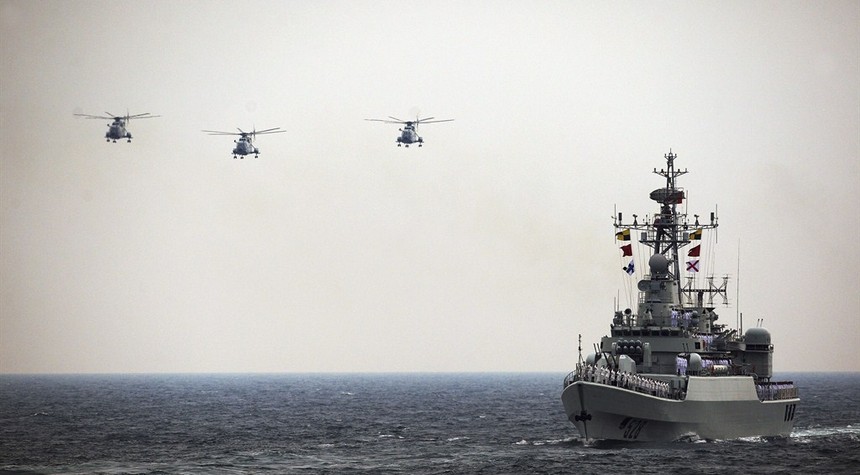Chinese and Russian Warships Come Uncomfortably Close to Alaska - Thanks, Biden
China and Russia have both been making aggressive moves toward the United States recently and their latest efforts, which included a joint naval exercise far too close to Alaska for comfort, further underscore their willingness to escalate.
With the U.S. focused on aiding Ukraine’s efforts to repel the Russians, the fact that tensions between the U.S. and China have been ratcheting up as well is inescapable — unless you’ve been living under a rock. Or perhaps at 1600 Pennsylvania Avenue. As Joe Cunningham observed in his column yesterday, We Might Be in a Cold War With China, and Joe Biden Just Doesn’t Know About It.
We’ve had spy balloons, Chinese “police stations” and biolabs on U.S. soil, and, just recently, a pair of sailors who were caught selling some major secrets to the Chinese military. None of this really bodes well for our relationship with China, a hostile foreign power that the Biden administration has been simultaneously pretending to be tough on while also kowtowing to them.
His article also included this helpful tweet timeline from our Townhall colleague, John Hasson:
(Note: The spy balloon incident was actually in February, as Hasson notes in a follow-up tweet.)
And that list barely scratches the surface of recent provocative moves by China, on top of their repeated snubs directed at the Biden administration.
Andrew Malcolm also recently shared his observations regarding “Joe Biden’s Inexplicable and Disturbing Attitude Toward China” in this Malcolm on the Right Commentary, observing:
Joe Biden definitely has something going on with China. He’s been remarkably passive given the increasing power and aggressiveness of Beijing’s Communist leaders.
…
It appears those Democrats are not paying attention or don’t want to. China’s navy concentrated in and around China has now surpassed the U.S. fleet with 340 vessels expected to increase to 400 by 2025. By comparison, the U.S. Navy has 300 ships scattered around the world and is scheduled to shrink to 294.
Speaking of the navy, as alluded to above, things got a bit chippy on Saturday after Chinese and Russian warships came uncomfortably close to Alaska.
The joint operation, conducted by two significant American adversaries, consisted of 11 ships and neared Alaska’s southwestern coast, according to Sen. Dan Sullivan, R-Alaska, who was briefed on the matter earlier this week by U.S. defense officials. Sullivan said the U.S. Navy ultimately mobilized four destroyers to guide the Chinese and Russian ships away from American waters.
“This is unprecedented in terms of the size and scope of this joint naval task force between Russia and China, working very closely together,” Sullivan told Fox News Digital in a phone interview late Saturday. “Whether you live in Alaska like I do, or on the East Coast of the United States, a very large surface action task force between our two main adversaries, probing very closely to United States shores is concerning.”
“It just solidifies this idea that we’ve entered a new era of authoritarian aggression led by the dictators in Beijing and Moscow who are increasingly aggressive,” he continued.
At least at this point, the U.S. Navy was able to address the situation by helpfully “guiding” the adversarial ships away from our waters. Though the ships did not actually enter U.S. territorial waters, they neared the Aleutian Islands, prompting the U.S. response, which included a P-8 Poseidon aircraft to “shadow” the ships as well.
There was a lot of discussion following Hunter Biden friend and business associate Devon Archer’s interview with the House Oversight Committee members and subsequent interview with Tucker Carlson regarding the importance of “signals.” Though the immediate crisis in the waters off Alaska may have been averted, there’s no mistaking the signals being sent by China and Russia with these maneuvers.
“It is a historical first,” said Brent Sadler, a senior research fellow at the Heritage Foundation and a retired Navy captain. “Given the context of the war in Ukraine and tensions around Taiwan, this move is highly provocative.”
In January, U.S. Air Force General Michael Minihan, commander of the Air Mobility Command, caused a great deal of consternation when he predicted that we were two years away from being at war (as in hot war, not cold) with China. I tend to share streiff’s assessment of Minihan’s prediction:
I don’t know how much impact General Minihan will have, but he clearly identified the problem. China is a hyperaggressive power that has a relatively small window of opportunity to achieve its dream of destroying the Republic of China and returning control of Taiwan to Beijing. We can refuse to believe them when they publicly proclaim their goals, but we do so at our peril.
One glaring example of the apparent inability or unwillingness of the U.S. to read the signs that China’s been flashing was highlighted by columnist and author Gordon Chang on Saturday.
Referencing the Biden administration’s plan to issue an executive order restricting investment in “sensitive technologies,” such as AI, semiconductor chips, and quantum computing, in China just ahead of U.S. Secretary of Commerce Gina Raimondo’s planned trip to Beijing in late August, Chang observed:
The #BidenAdministration has delayed the issuance of this order for almost a year, hoping that #China would show signs of cooperation. #XiJinping, however, has made it clear that his regime will go to war, leaving #America with no other choice.
Pinning our future dealings with China on “hope” seems like a losing proposition. The Biden administration appears not to have gotten that message yet.





Post a Comment